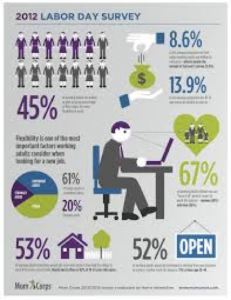Workplace Flexibility
Would you rather have a successful personal life or a successful professional life? You may not have to choose. The workplace is changing, along with employee’s expectations. Discussions on flexibility in the workplace are trending, and for good reason.
Implementing workplace flexibility is becoming a make or break decision. Companies with flexibility are experiencing more engaged employees, larger profit margins, and greater retention. The switch does not take a lot of money; it takes a lot of courage.
Are Employees In Seats A Valid Measure Of Commitment?

Not all work is happening at work. Shifts in technology and an always changing market is why flexibility is becoming the new norm. Some people believe that if you are not in the office you are not working, if you are not making face time with co-workers and the boss you are not truly committed, and long hours are the best measure of productivity. Well, not exactly. Studies show that employees are most engaged in their work when spending 20-50% of their time working remotely and the remainder in the office. In the industrial age, a 40-hour work week, was necessary to support a family. This was when males were the primary breadwinners and women were homemakers. Now only 20% of families fit that model, and the workforce is comprised of 50% women. We are in the information age now, it is time to adjust.
So What Are the Benefits?
Flexibility does not just benefit employees; companies that offer flexibility actually save more money. That’s right, by utilizing flexible schedules a company will see utility bills shrink, need for office space diminish, less office equipment to be purchased and maintained, and reduced turnover. Reduced turnover means saving the money it takes to recruit and hire new, quality talent. In case you are looking to hire though, offering flexibility will broaden the pool of candidates. In a study done by Labor Day Workplace 61% of people listed flexibility as one of the most important factors when looking for a new job. Not only will you be a more attractive employer, but you will also be able to hire people based on talent rather than location. Another major benefit of workplace flexibility is increased productivity. Ellen Ernst Kossek, a distinguished professor at the University of Michigan, conducted extensive research that proved employees to be more productive and engaged when they can make choices about how, where, and when they work.
Who’s Doing It?
Netflix, Zynga, Virgin Group, Evernote, JP Morgan Chase, and many more are enjoying the benefits of workplace flexibility. Netflix, one of the industry leaders in flexible work, believes that a talented worker does not need to put in a certain amount of hours behind a desk to produce quality work. For this reason Netflix employees enjoy flexible work hours and an unrestricted number of vacation days. Netflix stated, “We should focus on what people get done, not on how many hours or days worked. Just as we don’t have a nine-to-five policy, we don’t need a vacation policy.” The owner of Virgin Group was quick to adopt the same policy after seeing the results of higher morale, creativity and productivity. At Virgin Group all salaried staff can take off whenever they want for however long they want. Mass Relevance a social engagement startup calls it “freesponsibility.” They believe that the more trust you put in your employees the more you will get from them. By no longer managing vacation times these companies were able to save 52 hours a year. Think what your company could do with all of that extra time!
What Options Are Out There To Make My Workplace More Flexible?
By now you are probably asking yourself, how can my workplace implement flexibility? Some options include flexible work hours, compressed workweeks, job sharing, reduced hours, and telecommuting. Here is a breakdown: Flexible work hours allow employees to start and end their workday at a different time from the standard. Compressed workweeks enable employees to work less days for longer hours, such as 4 days a week for 10 hours. Job sharing is when a full-time position is shared between two part-time employees. Reduced hours is when a company allows employees to work less than 36 hours a week. Lastly, telecommuting is when an employee can work from a remote location one or more days a week. With so many options available, at least one will work for both the employees and employer.






Leave a Reply
Want to join the discussion?Feel free to contribute!